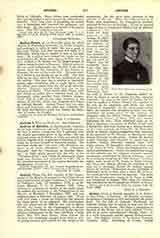

Andrea Pisano, or DA PISA (the name by which Andrea da Pontadera is known), an Italian sculptor and architect, b. 1270; d. 1349. He was a pupil of Giovanni Pisano, and first learned the trade of a goldsmith, which was of benefit to him in his later work. He is said to have helped his master on the sculpture for St. Maria della Spina, in Pisa, and to have worked on St. Mark’s and the Doge’s palace, at Venice, before he went to Florence. Here he achieved the one work indisputably his; the first of the three bronze doors for the baptistery of the Duomo at Florence, the one on the south side. He spent years on it before it was finally set up in 1336. The date 1330 on the door refers to the wax model and not to the casting. The door has a number of quatrefoil panels, eight containing only a single figure, while the others have scenes from the life of St. John the Baptist. Pisano’s mature style was due to the influence of Giotto. After Giotto died, Pisano built two stories of niches above Giotto’s work on the Campanile, quite possibly from Giotto’s designs. From 1347 to 1349 he was chief architect of the duomo of Orvieto, which was designed and begun by Lorenzo Maitani Andrea Pisano had two sons, Nino and Tommaso, who were also sculptors, but his most distinguished pupil was Andrea da Cione, who is known as Orcagna.
JOHN J. A’ BECKET

